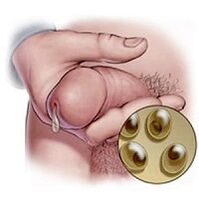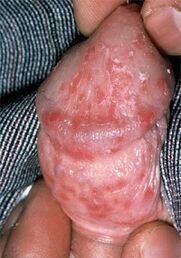
Secretion from Organs genitals in men is the secretion from the urethra (urethra) and the secret from the preputial glands, which are located in the head of the penis, under the skin of the foreskin. The ejaculatory duct, prostate ducts, urethral and bulbourethral glands open into the urethra.
In a healthy man, only urine and ejaculation flow through the urethra. This is a physiological discharge from the penis and should not cause any discomfort. Unfortunately, this is not always the case.
For various reasons, men's health is shaking and instead of normal discharge, abnormal discharge or urine and semen change appear.
Variants of Physiological Secretions
Criteria for normal discharge corresponding to the functions of the organs of the urogenital system:
- Urine - clear, straw to golden yellow in color, practically odorless, with no flakes or other inclusions;
- The prostate secret has a viscous consistency and a whitish hue, there is a specific spermine odor;
- Ejaculated: sperm from the ejaculatory duct mixes with secretions from the Littre (urethral), Cooper (bulbourethral) and prostate glands, acquiring grayish-white color and mucosal consistency;
- Fresh smegma from the preputial glands is like a thick, white fat; may turn yellowish or greenish over time.
Prepucial lubricant - smegma - is constantly released, accumulating under the inner layer of the foreskin and in the coronal sulcus of the penis. The lubricant is composed of grease and bacterial residues, is evenly distributed and reduces friction between the skin of the foreskin and the glans. The maximum activity of the preputial glands is inherent in the puberty period; with age, the secretion decreases and stops completely in old age.
If you neglect personal hygiene rules, smegma can accumulate under the folds of the foreskin. In this case, the grease part of the lubricant is oxidized, and the protein part decomposes (actually, it is rotting), and the masses turn greenish, acquiring an unpleasant odor. The same process occurs with phimosis, when, due to the fusion of the foreskin, it is impossible to completely free the head of the penis from the skin folds and remove the smegma. Lubricant buildup and breakdown can lead to chronic balanitis and balanoposthitis (inflammation of the foreskin and glans penis), increasing the risk of developing tumors.
Urethrorrhea, colorless mucous secretion from the bulbourethral and urethral glands. High data appear in men with arousal associated with libido. Clear mucus excretion aims to lubricate the urethra and improve semen passage. The amount of secretion varies from scarce to abundant, these parameters are associated with the individual characteristics of the organism and the frequency of sexual activity. After prolonged abstinence, the volume of secretions increases.
Pollution is a spontaneous release of sperm, not associated with sexual intercourse. Usually seen in the morning when testosterone levels rise. It depends on age and intensity of sexual activity: it appears in boys during puberty, in adult men - with irregular or rare sexual intercourse.
Prostatorrhea, secretion from the urethra of a small amount of clear mucus with grayish-white inclusions. It occurs after tension in the abdominal muscles (eg with constipation) or after urination. The secret is a mixture of semen and prostate secretion, swelling and opacity can be signs of prostatitis.
pathological discharge
In men, the causes of penile secretion can be sexually transmitted diseases, tumors, nonspecific inflammation of Organs urogenital organs, various injuries, manipulations or medical operations.
Pathological discharge from the urethra differs from normal:
- By volume (very abundant or scarce, possibly moderate);
- In color and transparency (from white to greenish yellow, cloudy);
- By impurities (blood, pus, mucus lumps);
- Consistencies (too thin or too thick and sticky);
- By the smell (sour, putrid, suspicious);
- By frequency of occurrence (depending on the time of day, constant or episodic discharge);
- In connection with urination, sexual arousal, with drinking alcohol, spicy and spicy foods.
The nature of the discharge depends on the causative agent of the disease, the state of the immune system, concomitant illnesses, as well as the severity and duration of the inflammation (acute or chronic).
If there is a change in the amount, density or color of the discharge, if an unpleasant odor appears, it is recommended to consult a doctor and undergo tests. Self-diagnosis is not worthwhile, it is very difficult to correctly recognize the disease by just one symptom.
Discharge from the penis associated with sexually transmitted diseases

Mucous: A small amount of transparent, viscous secretion found in the chronic form of chlamydial urethritis, mycoplasma, or ureaplasma. Microscopy reveals a moderate number of white blood cells in the secretions (the norm is up to 4 cells per field of view).
Mucopurulent: white, translucent discharge; seen in the exacerbation phase with chlamydia, ureaplasmosis and mycoplasmosis. In chlamydia infections, they accumulate on the head of the penis, as if they "stick" to the skin.
With the pathologies described above, the discharge will come from the urethra itself, as the microorganisms irritate the mucous membrane of the urethra, and the body tries to "wash it".
It turns out that the secret of the white color seems to cover the head. This is seen with chlamydia, candidiasis. In the first case a film is formed, in the second - a loose cheese flower.

Purulent discharge with an unpleasant odor is characteristic of gonorrhea. They are sticky, thick, yellow or greenish in color, with a putrid odor. Microscopic examination of the material shows urethral epithelial cells, many leukocytes.
Symptoms accompanying gonorrheic urethritis: persistent, profuse discharge; pain, itching and burning are especially severe when urinating.
In sexually transmitted diseases, combined infections are often observed, combining several pathogens at the same time. Gonorrhea and trichomoniasis are accompanied by chlamydia, mycoplasmosis and ureaplasmosis are usually found in pairs. The symptoms of these diseases differ from the classic manifestations, the urethral discharge can also acquire a completely different character. Therefore, for the final diagnosis, modern analytical techniques with a high degree of reliability are used, and not the discharge characteristics.
Non-specific (non-venereal) inflammation
The cause of nonspecific inflammation is its own microflora, which is conditionally pathogenic and is activated only in case of problems with the body's immune defense. Streptococci and staphylococci, Candida fungi and E. coli are always present on the skin surface and in the mucous membranes, but they begin to actively multiply and displace beneficial bacteria after hypothermia, prolonged stress, uncontrolled antibiotic treatment, after courses of radiation and chemotherapy.
Non-gonorrheic (non-specific) urethritis. The inflammatory discharge is small in volume, visible in the urine as mucopurulent cords or lumps that appear early in the disease. Symptoms in the form of burning and itchy urination are less pronounced than in gonorrhea, but craving is frequent and does not provide relief. With an ascending infection, the bladder becomes inflamed first, followed by the ureters and kidneys; secretion appears with a mixture of scarlet blood.

Candidiasis (thrush), fungal infection of the urethra. It usually develops in the context of suppression of the immune system after a course of antibiotics, chemotherapy, or radiation therapy; sexual transmission of candidiasis in men is rare. Candidiasis is characterized by a curdled discharge with a sour odor, which combines with itching and burning during urination (urinating) and ejaculation (ejaculation), and may be accompanied by dull pain in the groin, above the pubis and lower back .
Gardnerellosis of the urethra. The fishy smell of the discharge is characteristic; they are sparse, yellowish-white or greenish. According to some classifications, gardnerellosis is referred to as an STD, but in men, sexual Gardnerella infection is more likely a curiosity. In fact, this disease is associated with a violation of the normal microflora, that is, dysbiosis. In its treatment, immunocorrectors and probiotics (lactic acid bacteria) are obligatorily used.
Balanoposthitis, inflammation of the foreskin. An abundant purulent discharge is observed locally, a mucus mixture is possible. Always accompanied by edema and hyperemia (redness) of the foreskin leaves, pain in the head of the penis.
With prostatitis, a cloudy discharge appears at the end of urination, abundant discharge - in the acute period of inflammation; sparse and white - with the transition from the disease to the chronic form. Prostatitis is usually complicated by difficulty urinating and poor erection, in severe cases - even anuria (complete absence of urine flow) and impotence.
Discharge not associated with inflammation

Spermatorrhea - secretion in the form of passively flowing sperm occurs outside of sexual intercourse or masturbation, without the sensation of orgasm. The reasons are some nervous system disorders, spinal injuries, chronic stress, and any prolonged inflammation of the genital area. Spermatorrhea is associated with a violation of innervation and a decrease in the tone of the vas deferens.
Hematorrhea, blemishes. It often appears with lesions of the urethral canal received during bougienage, after insertion of a catheter, or when taking a mucous membrane smear. In these cases, the blood is fresh, free of clots, the amount is small, the bleeding stops quickly. When small kidney stones or sand disappear, blood is released during or immediately after urination, the hematorrhea is accompanied by severe pain (renal colic). The discharge of blood in the haematuric form of glomerulonephritis (inflammation of the renal glomeruli) is combined with edema and consistent high blood pressure, the appearance of protein in the urine.
Brown discharge, with blood clots or mucus, with a mixture of pus, appear in malignant tumors that emanate from the prostate, urethra or bladder. Brownish mucus can form during wound healing in the mucous membranes and is secreted with polyposis of the urethra and/or bladder.
Prostatorrhea is the secretion of the prostate that flows from the urethra. Occurs in chronic prostatitis, prostate adenoma, impaired innervation (neurogenic bladder).
Algorithm for examination in the presence of pathological penile secretion

- Examination of the perineum, penis, foreskin and glans. The objective is to identify deformities of Organs genital organs, traces of their lesions, signs of external inflammation, discharge, rash, etc. Traces of secretion are sometimes noticeable on linen.
- Palpation of the inguinal lymph nodes, assessment of their status: size, they are warmer or colder than the surrounding tissues, painful or not, soft or dense, mobile or adherent to the skin, whether there are ulcerations on top.
- Examination of the prostate finger; massage of the prostate through the rectum and obtaining secretions for microscopic examination. Before massage, it is advisable not to urinate for 1-2 hours. In the case of prostate adenoma, its lobes are enlarged approximately equally, dense strands are felt. For a malignant tumor, irregular growths and their consistency are typical; during palpation of the prostate, blood with clots may be released from the urethra.
- Material - smears for microscopy and culture. When examined under a microscope, a stained smear shows blood cells, epithelium, sperm, fat inclusions, some pathogens (Escherichia coli, gonococci, gardnerella, yeast). An increase in the number of leukocytes is characteristic of acute urethritis or exacerbation of chronic inflammation, eosinophils - for urethritis with allergies. Erythrocytes are found in severe inflammation, tumors, lesions of Organs genitourinary organs, urolithiasis. A large amount of epithelium is a sign of chronic urethritis, urethral leukoplakia. With spermatorrhea, sperm cells are found in a smear, with uretorrhea - mucus, prostatorrhea - lipid grains. For informational content and reliability of results, the swab is collected no earlier than 3 days after topical application of antibiotics, antifungals, and disinfectants. If antibiotic treatment was systemic, at least 3 weeks should pass after the course. Before making a smear, do not wash, try not to urinate for 2-3 hours.
- General clinical analysis of blood, blood for sugar - in the morning on an empty stomach. Expanded urinalysis (morning portion, immediately after sleep).
- Prostate, bladder and kidney ultrasound; CT and urography.
If the manifestations of genital inflammation are strong, before test results are obtained, the patient is immediately given broad-spectrum antibiotics. With profuse bleeding, hospitalization and active actions to stop the bleeding are indicated. Confirmation of suspected malignant tumor can only be the result of a biopsy, the final diagnosis being made based on histological examination.
Important:
- Discharge from the penis is just one symptom that cannot be addressed when making a diagnosis.
- Independent nomination of the farm is unacceptable. medications, even if the manifestations seem obvious for a specific disease.

























